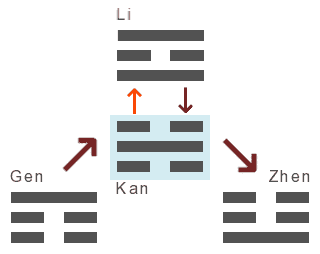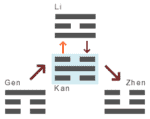What does Kan represent?
Kan represents our primal trust and unconscious resources. It signifies the very foundation from which we, as beings who act and shape our world, derive.
The challenging aspect of this situation is that this, our own primal foundation, contains elements that are beyond our conscious grasp. As the name suggests, unconscious contents lie beyond our everyday awareness. These unconscious aspects of our being can encompass our own experiences and knowledge, but sometimes they may also knowledge external or even transgenerational contents.
As a result, impulses and inspirations arise from Kan and guide us towards decisions and actions without our complete understanding or conscious recognition of their origin and purpose.
Impulses and Inspirations from the Unconscious
Possibly, this is why many interpretations of the I Ching perceive Kan as negative and dangerous: Kan possesses a self-dynamic that our intellect cannot fully control, if at all. The negative judgment of Kan might stem from the desire to control the unconscious, which is ultimately impossible.
However, if we let go of the attempt to control unconscious contents through our conscious awareness and accept the unconscious for what it is – something beyond our conscious knowing – Kan can become a valuable resource. When we simply follow our intuition and inspiration, our actions often acquire a unique quality that feels right and harmonious in a special way.
Our Unconscious Shapes Our Perception of the World
In fact, Kan harbors a further intriguing aspect: the realization of how profoundly our own primal foundation, our unconscious, influences our perception of the world. It is true that externally, I encounter my environment – a world seemingly separate from myself. However, what I see, what presents itself to me, is heavily influenced by my own inner disposition. I perceive the world that I encounter through the lens of my own unconscious, as if wearing glasses on my nose. My glasses, on my nose.
What happens when I become aware of these glasses?
In the sequence of King Wen’s Later Heaven, Kan is associated with the functional circuit of the Kidney (possibly also the Bladder). The Kidney (KI) functional circuit in Traditional Chinese Medicine also refers to our ancestors. This could explain why certain contents of our unconscious can trace back through multiple generations. Relevant quotes to deepen the points discussed here can be found on the page Phase Element Water: Kidney
Following the Path of the Dao: What is Really Happening?
In the model of Follow the Path of the Dao, Kan represents one of the two test points. A test point is a pivotal moment where a movement abruptly changes direction, and its dynamics may be challenging to control. In the context of the model, Kan shifts the focus from the relationship with oneself to the relationship with the world, revealing the extent to which internal integration has already developed and matured.
Questions for self-exploration could include, for example:
- Primal trust or primal fear – who is actually in control here with me?
- Does my current emotional state genuinely relate to the situation I find myself in? (And if not, where do these feelings originate? Where do they truly belong?)
- Through what lens do I perceive the world? What is the nature of this – my own! – lens? What would I see without it? What is truly happening?
What does Kan emerge from?

Within a hexagram Kan develops either from Gen or Li (exception: the hexagram begins Kan / Kan is the lower trigram). The dark arrows indicate that a (broken) yin line is added to each previous trigram. Yin symbolizes receptiveness. We must be receptive in order to connect to our gut knowledge.
Kan emerges from Gen, the Mountain
Gen, the mountain, represents disengagement, which in turn creates a pathway for us to reconnect with our spiritual self: our intuitive wisdom, our essence accumulated on our journey to the present moment, and ready to nurture us.
Examples of hexagrams where Kan emerges from Gen → here.
Kan emerges from Li, the Fire
Our ability to intellectually differentiate impressions, facts, feelings etc. (Li, the fire) provides us with clarity and fosters a sense of tranquility. A peaceful mind makes it easier for us to trustfully open ourselves to messages from our spiritual grounds: gut feelings, intuitions, and presentiments.
Examples of hexagrams where Kan emerges from Li → here.
What does Kan develop into?

Within hexagram a Kan develops either into Zhen or Li (exception: the hexagram ends with Kan / Kan is the upper trigram).
Kan develops into Zhen, the Thunder
Zhen, the thunder, emerges when a (broken) yin line is added (dark arrow; yin symbolizes receptivity). Trusting our gut feelings, being receptive to impulses from our unconscious resources gives birth to the primal seed of a new action, the initial step in a new direction.
Examples of hexagrams where Kan develops into Zhen → here.
Kan develops into Li, the Fire
Li, the fire, develops when a (solid) yang line is added (red arrow; yang symbolizes energy, activity). The mind (Li) and the gut (Kan) often appear to strive into different directions. However, upon closer examination, we may find the clue to the inner logic of own existence: what seemed contradictory unties into personal strength.
Examples of hexagrams where Kan develops into Li → here.
References
Phase Element: Water
Functional Circuit: Kidney (KI)
Modern Interpretation
Basic trust; intuition; ancestral energy
Traditional Interpretation
Abysmal, dangerous, exposed to uncontrollable forces
Direction: downwards
Interpretation: danger from the outside which must be addressed carefully; abysmal depths; beyond: new energies



